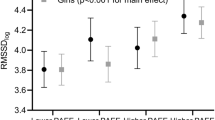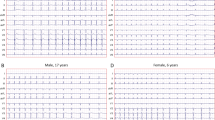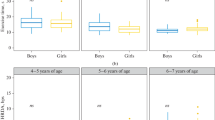Abstract
Blood pressure and heart rate were measured at rest and during a television video game in 399 healthy children. At the first assessment, children were in third grade and at the 2-year follow-up, they were in fifth grade. Children were classified according to race (black/white), gender (boy/girl), body mass index (light/heavy), and video game performance (low score/high score). Correlational analysis indicated that irrespective of the classification variable, absolute reactivity values, e.g., a heart rate of 110 bpm, tended to be more stable than change reactivity values, e.g., a heart rate change of 10 bpm. The greater stability of absolute values was most pronounced with systolic blood pressure. Absolute values were at least as stable as resting values and frequently demonstrated greater stability. Mean and maximal reactivities were correlated comparably. We conclude that children's reactivity is a stable characteristic and that, unless indicated by a priorihypotheses, the use of absolute values is preferable to the use of change values.
Similar content being viewed by others
References
Barnett, P. H., Hines, E. A., Schirger, A., and Gage, R. P. (1963). Blood pressure and vascular reactivity to the cold presser test: Restudy of 207 subjects 27 years later.JAMA 183: 845–848.
Berenson, G. S., Frank, G. C., Hunter, S. M., Srinivasan, S. R., Voors, A. W., and Webber, L. S. (1982). Cardiovascular risk factors in children.Am. J. Dis. Child. 136: 855–862.
Borghi, C., Costa, F. V., Boschi, S., Mussi, A., and Ambrosioni, E. (1986). Predictors of stable hypertension in young borderline subjects: A five-year follow-up study.J. Cardiovasc. Pharmacol. 8: S138-S141.
Chaney, R. H., and Eyman, R. K. (1988). Blood pressure at rest and during maximal dynamic and isometric exercise as predictors of systemic hypertension.Am. J. Cardiol. 62: 1058–1061.
Clarke, W. R., Schrott, H. G., Leaverton, P. E., Connor, W. E., and Lauer, R. M. (1978). Tracking of blood lipids and blood pressures in school age children: The Muscatine Study.Circulation 58: 626–634.
Davidoff, R., Schamroth, C. L., Goldman, A. P., Diamond, T. H., Cilliers, A. J., and Myburgh, D. P. (1982). Postexercise blood pressure as a predictor of hypertension.Aviat. Space Environ. Med. 53: 591–594.
Dlin, R. A., Hanne, N., Silverberg, D. S., and Bar-Or, O. (1983). Follow-up of normotensive men with exaggerated blood pressure response to exercise.Am. Heart J. 106: 316–320.
Falkner, B., Kushner, H., Onesti, G., and Angelakos, E. T. (1981). Cardiovascular characteristics in adolescents who develop essential hypertension.Hypertension 3: 521–527.
Ferguson, G. A., and Takone, Y. (1989).Statistical Analysis in Psychology and Education, 6th ed., McGraw-Hill, New York.
Frerichs, R. R., Webber, L. S., Voors, A. W., Srinivasan, S. R., and Berenson, G. S. (1979). Cardiovascular disease risk factor variables in children at two successive years—the Bogalusa Heart Study.J. Chron. Dis. 32: 251–262.
Gillum, R. F., Taylor, H. L., Anderson, J., and Blackburn H. (1981). Longitudinal study (32 years) of exercise tolerance, breathing response, blood pressure, and blood lipids in young men.Arteriosclerosis 1: 455–462.
Goldstein, D., Fink, D., and Mettee, D. R. (1972). Cognition of arousal and actual arousal as determinants of emotion.J. Pers. Soc. Psychol. 21: 41–51.
Hait, H. I., Lemeshow, S., and Rosenman, K. D. (1982). A longitudinal study of blood pressure in a national survey of children.Am. J. Public Health 72: 1285–1287.
Harlan, W. R., Oberman, A., Mitchell, R. E., and Graybiel, A. (1973). A 30-year study of blood pressure in a white male cohort. In Onesti, G., Kim, E. E., and Mayer, J. H. (eds.),Hypertension: Mechanisms and Management, Grune & Stratton, New York, pp. 85–91.
Jackson, A. S., Squires, W. G., Grimes, G., and Beard, E. F. (1983). Prediction of future resting hypertension from exercise blood pressure.J. Card. Rehabil. 3: 263–268.
James, G. D., Pickering, T. G., Yee, L. S., Harshfield, G. A., Riva, S., and Laragh, J. H. (1988). The reproducibility of average ambulatory, home, and clinic pressures.Hypertension 11: 545–549.
Lacey, J. I., and Lacey, B. C. (1962). The law of initial value in the longitudinal study of autonomie constitution: Reproducibility of autonomie responses and response patterns over a four-year interval.Ann. N.Y. Acad. Sci. 98: 1257–1290, 1322–1326.
Lauer, R. M., Clarke, W. R., and Beaglehole, R. (1984). Level, trends, and variability of blood pressure during childhood: The Muscatine Study.Circulation 69: 242–249.
Mahoney, L. T., Schieken, R. M., Clarke, W. R., and Lauer, R. M. (1988). Left ventricular mass and exercise responses predict future blood pressure: The Muscatine Study.Hypertension 12: 206–213.
Manuck, S. B., Kasprowicz, A. L., Monroe, S. M., Larkin, K. T., and Kaplan, J. R. (1989). Psychophysiologic reactivity as a dimension of individual differences. In Schneiderman, N., Weiss, S. M., and Kaufman, P. (eds.),Handbook of Research Methods in Cardiovascular Behavior Medicine, Plenum, New York, pp. 365–382.
Matthews, K. A., and Stoney, C. M. (1988). Influences of sex and age on cardiovascular responses during stress.Psychosom. Med. 50: 46–56.
Matthews, K. A., Woodall, K. L., and Stoney, C. M. (1990). Changes in and stability of cardiovascular responses to behavioral stress: Results from a four-year longitudinal study of children.Child Dev. 61: 1134–1144.
Menkes, M. S., Matthews, K. A., Krantz, D. S., Lundberg, U., Mead, L. A., Qaqish, B., Liang, K. Y., Thomas, C. B., and Pearson, T. A. (1989). Cardiovascular reactivity to the cold pressor test as a predictor of hypertension.Hypertension 14: 524–530.
Murphy, J. K., Alpert, B. S., Walker, S. S., and Willey, E. S. (1988). Race and cardiovascular reactivity: A replication.Hypertension 11: 308–311.
Murphy, J. K., Alpert, B. S., Dupaul, L. M., Willey, E. S., Walker, S. S., and Nanney, G. C. (1990a). The validity of children's self-reports of physical activity: A preliminary study.J. Hum. Hypertens. 4: 130–132.
Murphy, J. K., Alpert, B. S., Stapleton, F. B., Miller, L. A., Willey, E. S., Walker, S. S., and Nanney, G. C. (1990b). Self-reports of salt intake by 10- to 18-year olds: Relationship to urinary sodium excretion.J. Am. Diet, Assoc. 90: 424–426.
Park, M. K., and Menard, S. M. (1987). Accuracy of blood pressure measurement by the Dinamap monitor in infants and children.Pediatrics 79: 907–914.
Parker, F. C., Croft, J. B., Cresanta, J. L., Freedman, D. S., Burke, G. L., Webber, L. S., and Berenson, G. S. (1987). The association between cardiovascular response tasks and future blood pressure levels in children: Bogalusa Heart Study.Am. Heart J. 113: 1174–1179.
Peterson, H. R., Rothschild, M., Weinberg, C. R., Fell, R. D., McLeish, K. R., and Pfeifer, M. A. (1988). Body fat and the activity of the autonomie nervous system.N. Engl. J. Med. 318: 1077–1083.
Sallis, J. F., Dimsdale, J. E., and Caine, C. (1988). Blood pressure reactivity in children.J. Psychosom. Res. 32: 1–12.
SAS Institute (1985).SAS User's Guide: Statistics, 5th ed., SAS Institute, Cary, NC.
Stoney, C. M., Davis, M. C., and Matthews, K. A. (1987). Sex differences in physiological responses to stress and in coronary heart disease: A causal link?Psychophysiology 24: 127–131.
Tanji, J. L., Champlin, J. J., Wong, G. Y., Lew, E. Y., Brown, T. C., and Amsterdam, E. A. (1989). Blood pressure recovery curves after submaximal exercise: A predictor of hypertension at ten-year follow-up.Am. J. Hypertens. 2: 135–138.
Thomas, J., Semenya, K. A., Neser, W. B., Thomas, D. J., Green, D. R., and Gillum, R. F. (1985). Risk factors and the incidence of hypertension in black physicians: The Meharry Cohort Study.Am. Heart J. 110: 637–645.
Visser, M. C., Grobbee, D. E., and Hofman, A. (1987). Determinants of rise in blood pressure in normotensive children.J. Hypertens. 5: 367–370.
Wilson, N. V., and Meyer, B. M. (1981). Early prediction of hypertension using exercise blood pressure.Prev. Med. 10: 62–68.
Wood, D. L., Sheps, S. G., Elveback, L. R., and Schirger, A. (1984). Cold pressor test as a predictor of hypertension.Hypertension 6: 301–306.
Wright, R. A., and Gregorich, S. (1989). Difficulty and instrumentality of imminent behavior as determinants of cardiovascular response and self-reported energy.Psychophysiology 26: 586–592.
Author information
Authors and Affiliations
Additional information
This research was supported by grants from the National Institutes of Health (HL-44847 and HL-35788).
Rights and permissions
About this article
Cite this article
Murphy, J.K., Alpert, B.S. & Walker, S.S. Whether to measure change from baseline or absolute level in studies of children's cardiovascular reactivity: A two-year follow-up. J Behav Med 14, 409–419 (1991). https://doi.org/10.1007/BF00845116
Accepted:
Issue Date:
DOI: https://doi.org/10.1007/BF00845116




